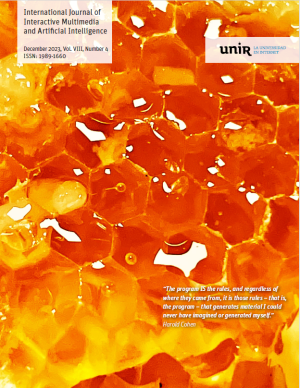Emotion-Aware Monitoring of Users’ Reaction With a Multi-Perspective Analysis of Long- and Short-Term Topics on Twitter.
DOI:
https://doi.org/10.9781/ijimai.2023.02.003Keywords:
Frequent Itemsets, Multi-perspective Topic Monitoring, Sentiment Analysis, Users’ Reaction PredictionAbstract
Social networks, such as Twitter, play like a disinformation spread booster giving the chance to individuals and organizations to influence users’ beliefs on purpose through tweets causing destabilization effects to the community. As a consequence, there is a need for solutions to analyse users’ reactions to topics debated in the community. To this purpose, state-of-the-art methods focus on selecting the most debated topics over time, ignoring less-frequent-discussed topics. In this paper, a framework for users’ reaction and topic analysis is introduced. First the method extracts topics as frequent itemsets of named entities from tweets collected, hence the support over time and RoBERTa-based sentiment analysis are applied to assess the current topic spread and the emotional impact, then a time-grid-based approach allows a granule-level analysis of the collected features that can be exploited for predicting future users’ reactions towards topics. Finally, a three-perspective score function is introduced to build comparative ranked lists of the most relevant topics according to topic sentiment, importance and spread. Experiences demonstrate the potential of the framework on IEEE COVID-19 Tweets Dataset.
Downloads
References
E. Tonkin, “Chapter 2 - a day at work (with text): A brief introduction,” in Working with Text, E. L. Tonkin, G. J. Tourte Eds., Chandos Information Professional Series, Chandos Publishing, 2016, pp. 23–60, doi: https://doi.org/10.1016/B978-1-84334-749-1.00002-0
X. Zhang, A. A. Ghorbani, “An overview of online fake news: Characterization, detection, and discussion,” Information Processing & Management, vol. 57, no. 2, p. 102025, 2020, doi: https://doi.org/10.1016/j.ipm.2019.03.004.
S. Loomba, A. Figueiredo, S. Piatek, K. de Graaf, H. Larson, “Measuring the impact of covid-19 vaccine misinformation on vaccination intent in the uk and usa,” Nature Human Behaviour, vol. 5, pp. 1–12, 2021, doi: 10.1038/s41562-021-01056-1.
Y. Kirill, I. G. Mihail, M. Sanzhar, M. Rustam, F. Olga, M. Ravil, “Propaganda identification using topic modelling,” Procedia Computer Science, 9th International Young Scientists Conference in Computational Science, YSC2020, 05-12 September 2020, vol. 178, pp. 205–212, 2020, doi: https://doi.org/10.1016/j.procs.2020.11.022
J. Dao, J. Wang, X. Zhang, “YNU-HPCC at SemEval-2020 task 11: LSTM network for detection of propaganda techniques in news articles,” in Proceedings of the Fourteenth Workshop on Semantic Evaluation, Barcelona (online), Dec. 2020, pp. 1509–1515, International Committee for Computational Linguistics.
V. Ermurachi, D. Gifu, “UAIC1860 at SemEval-2020 task 11: Detection of propaganda techniques in news articles,” in Proceedings of the Fourteenth Workshop on Semantic Evaluation, Barcelona (online), Dec. 2020, pp. 1835–1840, International Committee for Computational Linguistics.
V.-A. Oliinyk, V. Vysotska, Y. Burov, K. Mykich, V. B. Fernandes, “Propaganda detection in text data based on nlp and machine learning,” in MoMLeT+DS, 2020.
E. Ferrara, “Contagion dynamics of extremist propaganda in social networks,” Information Sciences, vol. 418-419, pp. 1–12, 2017, doi: https://doi.org/10.1016/j.ins.2017.07.030
S. Khan, S. Hakak, N. Deepa, B. Prabadevi, K. Dev, S. Trelova, “Detecting covid-19-related fake news using feature extraction,” Frontiers in Public Health, vol. 9, 2022, doi: 10.3389/fpubh.2021.788074.
M. A. Alonso, D. Vilares, C. Gómez-Rodríguez, J. Vilares, “Sentiment analysis for fake news detection,” Electronics, vol. 10, no. 11, 2021, doi: 10.3390/electronics10111348.
M. Huddar, S. Sannakki, V. Rajpurohit, “Attentionbased multi-modal sentiment analysis and emotion detection in conversation using RNN,” International Journal of Interactive Multimedia and Artificial Intelligence, vol. 6, no. 6, pp. 112-121, 2021, doi: 10.9781/ijimai.2020.07.004.
C.-H. Chen, P.-Y. Chen, J. Lin, “An ensemble classifier for stock trend prediction using sentence-level chinese news sentiment and technical indicators,” International Journal of Interactive Multimedia and Artificial Intelligence, vol. 7, no. 3, pp. 53–64, 2022, doi: 10.9781/ijimai.2022.02.004.
M. Charquero-Ballester, J. G. Walter, I. A. Nissen, A. Bechmann, “Different types of covid-19 misinformation have different emotional valence on twitter,” Big Data & Society, vol. 8, no. 2, p. 20539517211041279, 2021, doi: 10.1177/20539517211041279.
Y. Wang, R. Han, T. Lehman, Q. Lv, S. Mishra, “Analyzing behavioral changes of twitter users after exposure to misinformation,” in Proceedings of the 2021 IEEE/ACM International Conference on Advances in Social Networks Analysis and Mining, ASONAM ’21, New York, NY, USA, 2021, p. 591–598, Association for Computing Machinery.
N. Kalantari, D. Liao, V. G. Motti, “Characterizing the online discourse in twitter: Users’ reaction to misinformation around covid-19 in twitter,” in 2021 IEEE International Conference on Big Data (Big Data), 2021, pp. 4371–4380.
S.-Y. Lin, Y.-C. Kung, F.-Y. Leu, “Predictive intelligence in harmful news identification by bert-based ensemble learning model with text sentiment analysis,” Information Processing & Management, vol. 59, no. 2, p. 102872, 2022, doi: https://doi.org/10.1016/j.ipm.2022.102872
S. Kwon, A. Park, “Understanding user responses to the covid-19 pandemic on twitter from a terror management theory perspective: Cultural differences among the us, uk and india,” Computers in Human Behavior, vol. 128, p. 107087, 2022, doi: https://doi.org/10.1016/j.chb.2021.107087
P. Koukaras, C. Tjortjis, D. Rousidis, “Mining association rules from covid-19 related twitter data to discover word patterns, topics and inferences,” Information Systems, vol. 109, p. 102054, 2022, doi: https://doi.org/10.1016/j.is.2022.102054
K. Garcia, L. Berton, “Topic detection and sentiment analysis in twitter content related to covid-19 from brazil and the usa,” Applied Soft Computing, vol. 101, p. 107057, 2021, doi: https://doi.org/10.1016/j.asoc.2020.107057
J. Han, J. Pei, Y. Yin, “Mining frequent patternswithout candidate generation,” SIGMOD Rec., vol. 29, p. 1–12, may 2000, doi: 10.1145/335191.335372.
Y. Liu, M. Ott, N. Goyal, J. Du, M. Joshi, D. Chen, O. Levy, M. Lewis, L. Zettlemoyer, V. Stoyanov, “Roberta: A robustly optimized bert pretraining approach,” ArXiv, vol. abs/1907.11692, 2019.
R. Lamsal, “Coronavirus (covid-19) tweets dataset,” 2020. [Online]. Available: https://dx.doi.org/10.21227/781w-ef42, doi: 10.21227/781wef42.
Downloads
Published
-
Abstract275
-
PDF47









